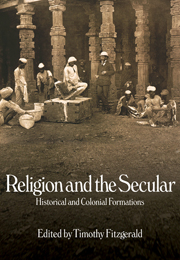Book contents
- Frontmatter
- Dedication
- Contents
- Acknowledgements
- Contributors
- Introduction
- 1 Dialectics of conversion: Las Casas and Maya colonial Congregación
- 2 A higher ground: the secular knowledge of objects of religious devotion
- 3 Secularizing the land: the impact of the Alaskan Native Claims Settlement Act on indigenous understandings of land
- 4 The formative process of State Shinto in relation to the Westernization of Japan: the concept of ‘religion’ and ‘Shinto’
- 5 Religious and secular in the Vietnam War: the emergence of highland ethno-nationalism
- 6 Colonialism all the way down? Religion and the secular in early modern writing on south India
- 7 Understanding politics through performance in colonial and postcolonial India
- 8 Real and imagined: imperial inventions of religion in colonial southern Africa
- 9 Religion in modern Islamic thought and practice
- 10 Rudolf Otto, cultural colonialism and the ‘discovery’ of the holy
- 11 Encompassing Religion, privatized religions and the invention of modern politics
- 12 Colonialism and the myth of religious violence
- Index
4 - The formative process of State Shinto in relation to the Westernization of Japan: the concept of ‘religion’ and ‘Shinto’
- Frontmatter
- Dedication
- Contents
- Acknowledgements
- Contributors
- Introduction
- 1 Dialectics of conversion: Las Casas and Maya colonial Congregación
- 2 A higher ground: the secular knowledge of objects of religious devotion
- 3 Secularizing the land: the impact of the Alaskan Native Claims Settlement Act on indigenous understandings of land
- 4 The formative process of State Shinto in relation to the Westernization of Japan: the concept of ‘religion’ and ‘Shinto’
- 5 Religious and secular in the Vietnam War: the emergence of highland ethno-nationalism
- 6 Colonialism all the way down? Religion and the secular in early modern writing on south India
- 7 Understanding politics through performance in colonial and postcolonial India
- 8 Real and imagined: imperial inventions of religion in colonial southern Africa
- 9 Religion in modern Islamic thought and practice
- 10 Rudolf Otto, cultural colonialism and the ‘discovery’ of the holy
- 11 Encompassing Religion, privatized religions and the invention of modern politics
- 12 Colonialism and the myth of religious violence
- Index
Summary
STATE SHINTO WITHIN THE LARGER PROCESS OF WESTERNIZATION
Accompanying the overseas advancement of various Western nation states, Christianity and even more so the very concept of ‘religion’ fundamentally based on Christianity came to proliferate throughout the world. Japan and other nations that were at least nominally politically independent came under the encroaching cultural dominance of the West. With the opening of the country to the West, mid-nineteenth-century Japan's status as a sovereign nation state remained elusive owing to unfair treaties established with Western countries. Whether Japan was to be acknowledged as an independent nation state, or instead follow the path of a colonial state depended on how well the country could adapt to a Western-style nation state model. Essential conditions to be achieved included the establishment of a constitution and recognition of Christianity. The recognition of Christianity took place in 1873, at which time a specific concept of religion began to spread throughout society primarily through intellectuals. This new concept of shûkyô or ‘religion’ was based on the central characteristics of Christianity but was also embraced as a larger category that included various other non-Christian practices and social formations that appeared in some respects analogous to Christianity.
Closely related to this new concept ‘religion’ were the ideas of ‘religious freedom’ and separation of church and state that came to proliferate. Following the principles of Westernstyle enlightenment, ‘religion’ (shûkyô) was entrusted to the sphere of the individual's interior freedom, while the ‘secular’ sphere of morality (dôtoku) was determined to be a national, and thus public, issue.
- Type
- Chapter
- Information
- Religion and the SecularHistorical and Colonial Formations, pp. 93 - 102Publisher: Acumen PublishingPrint publication year: 2007



